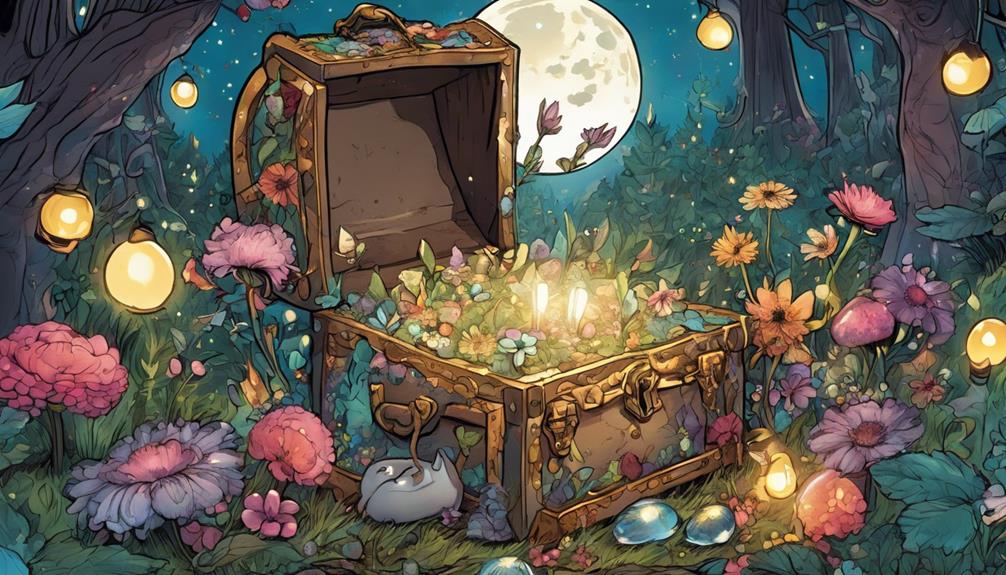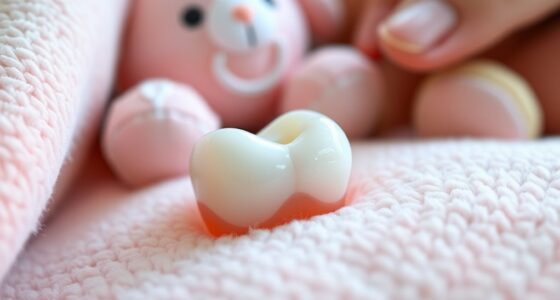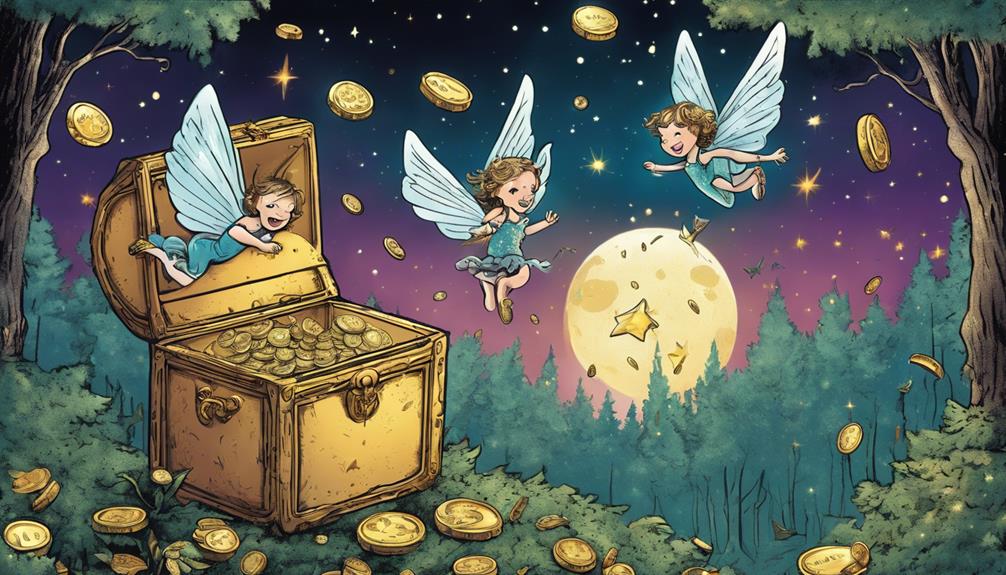The Tooth Fairy tends to favor certain teeth over others. Typically, a child's first lost tooth is the most valuable, often fetching between $5 to $20. As children grow, older lost teeth usually earn higher payouts compared to their younger siblings' teeth. Regional differences also play a role in how much the Tooth Fairy leaves, with more affluent neighborhoods generally offering bigger rewards. So, if you want to know if your child's teeth are worth more, consider milestones and local payment trends. There's much more to discover about maximizing those magical payouts!
Key Takeaways
- The first lost tooth often receives higher payouts, typically ranging from $5 to $20 due to its emotional significance.
- Regional differences influence payments, with the Northeast averaging $7.36 compared to the West Coast's $4.08.
- Milestone teeth, like canines, may also yield larger rewards, reflecting their importance in a child's dental development.
- Socioeconomic factors play a role, as affluent families tend to provide higher Tooth Fairy payouts.
Tooth Fairy Tradition Explained
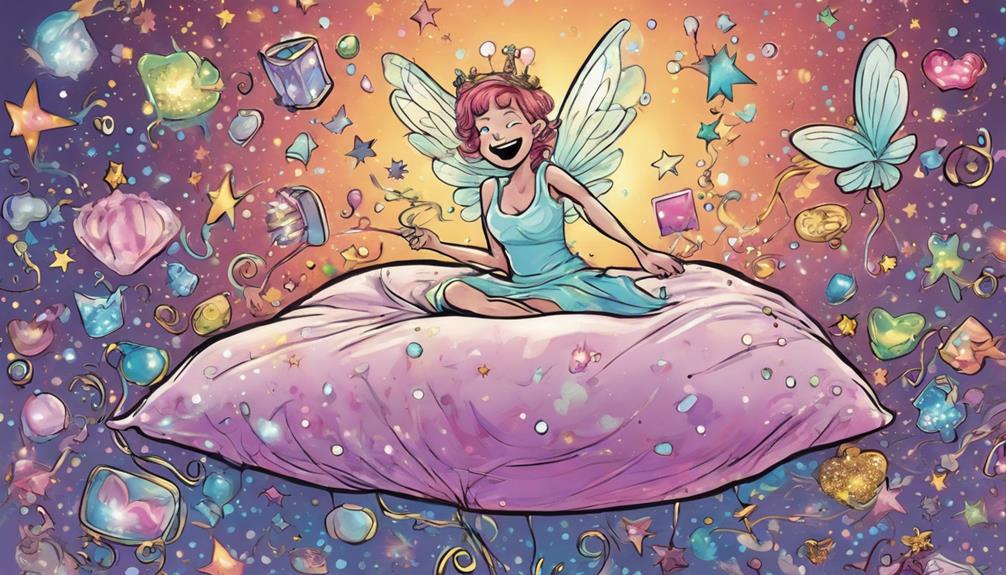
The Tooth Fairy tradition invites children to place their lost teeth under their pillows, transforming a moment of loss into a magical exchange for money or small gifts. This enchanting practice helps ease the anxiety that often accompanies losing a tooth. Historically, the concept traces back to ancient Norse customs and evolved from the 18th-century French tradition of La Bonne Petite Souris, where a mouse would collect teeth instead.
Typically, kids lose around 20 baby teeth, and many families create a special routine to heighten the excitement surrounding each Tooth Fairy visit. As children anticipate the arrival of the Tooth Fairy, they experience a sense of adventure and wonder, reinforcing the idea that losing a tooth is a significant milestone worth celebrating.
In recent years, the average payout from the Tooth Fairy has skyrocketed from $1.50 in 2000 to an impressive $6.23 in 2023, reflecting changing societal norms and economic factors. Overall, the Tooth Fairy tradition serves not just as a fun ritual but also as a comforting way to navigate the bittersweet experience of losing a tooth, turning it into a cherished childhood memory. Children eagerly anticipate the tooth fairy’s visit, often placing their lost tooth underneath their pillow in hopes of a generous payout. Parents play along with the tradition, sneaking in during the night to make the exchange and add to the tooth fairy’s collection of teeth. The belief in the tooth fairy continues to bring joy and excitement to children as they experience the milestone of losing their baby teeth. As children grow older, they may look back on their tooth fairy experiences with fondness and nostalgia, cherishing the memories of waking up to find a shiny coin or bill left in place of their tooth. Some families even create special tooth fairy traditions, such as leaving behind a small trinket or note from the tooth fairy. The tooth fairy’s collection of teeth holds sentimental value for many individuals, symbolizing the passage of time and the cherished moments of childhood.
Magical Gifts Vs. Cash Rewards

When your child loses a tooth, you can choose between giving cash or a magical gift.
While cash might seem exciting at first, it often lacks the imaginative spark that a special gift can provide.
Enriching Imagination Through Gifts
Magical gifts, like enchanting toys or whimsical treasure boxes, spark creativity and wonder in children far more than simple cash rewards ever could. When you choose to give your child a special gift instead of cash, you're not just handing over a tangible item; you're igniting their imagination and creating a memorable experience that they'll cherish. A teddy bear or a themed treasure box can transport them into a world of fantasy, fueling their creativity and encouraging storytelling.
By focusing on magical gifts, you reinforce the idea of wonder over materialism. This approach creates lasting memories tied to the Tooth Fairy tradition, making the experience of losing a tooth more meaningful. Children learn to value creativity, enhancing their imaginative play.
While cash rewards may provide basic educational opportunities, like counting coins, they often lack the excitement and engagement that come with a delightful gift.
Opting for magical gifts enriches your child's experience, establishing a deeper connection to their imagination. In a world where creativity can sometimes take a backseat, these enchanting gifts guarantee that the joy of wonder remains a vibrant part of their growing years.
Cash's Limited Excitement
Why settle for the mundane thrill of cash rewards when you can spark joy and imagination with a unique gift from the Tooth Fairy?
While cash payouts typically range from $1 to $20, many families are shifting towards magical gifts that enhance the excitement of losing a tooth. Instead of just receiving a few bucks, imagine your child waking up to a tiny treasure or a themed set that ignites their imagination.
Children often hoard their cash earnings, leaving those dollar bills feeling lackluster and unexciting. In contrast, magical gifts become memorable keepsakes that can inspire wonder and creativity.
Although integrating elements like foreign currency can add a sense of adventure, they still can't compete with the enchanting nature of a thoughtful gift.
Magical Experiences Matter Most
The thrill of losing a tooth can transform into a memorable adventure with unique gifts that captivate a child's imagination far more than cash ever could. When you shift from cash rewards to magical experiences, like themed treasures, you enhance the tooth loss journey.
Imagine your child waking up to a teddy bear or a toolbox from the Tooth Fairy—gifts that spark wonder and create lasting memories. While cash can add a sprinkle of excitement, it often lacks the enchantment of a thoughtfully chosen gift.
Children tend to hoard their Tooth Fairy earnings, showing a preference for the magic over monetary value. By focusing on magical experiences, you foster a deeper appreciation for the Tooth Fairy tradition and its lessons in financial literacy and delayed gratification.
Even incorporating foreign currency or unique coins can add a twist to cash rewards, emphasizing the magic of the tradition. Ultimately, it's those whimsical moments that linger in a child's heart, making the Tooth Fairy's visits far more meaningful than any simple cash exchange ever could.
Embrace the magic, and watch your child's imagination soar!
Understanding Tooth Fairy Payments
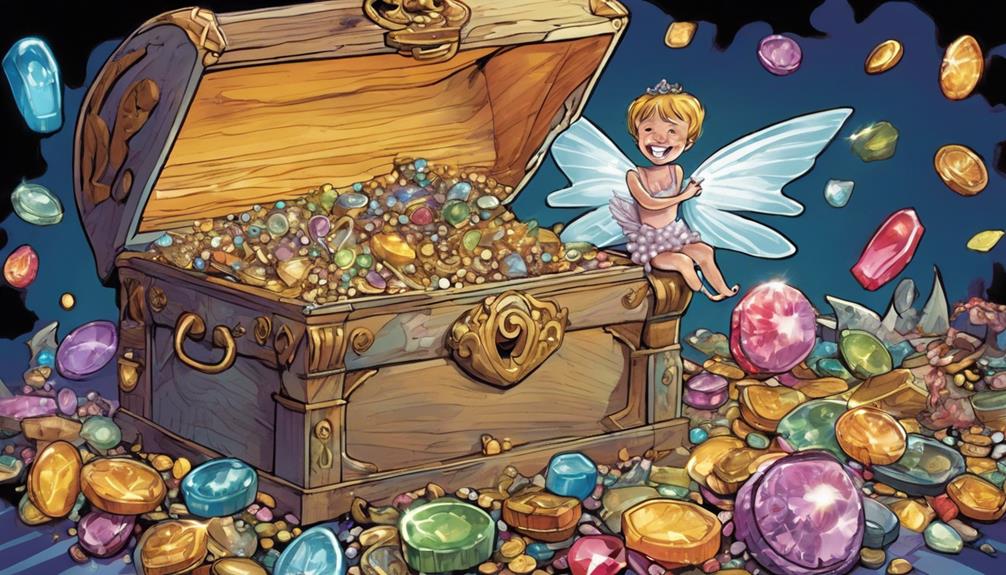
Understanding how much the Tooth Fairy pays can be surprising, as payments have nearly quadrupled over the past two decades. In 2000, the average payout was just $1.50, but by 2023, it jumped to $6.23. This increase reflects changing economic conditions and parental expectations about what a tooth is worth.
To help you understand Tooth Fairy payments better, here's a quick list of facts:
- Range of Payments: Tooth Fairy payouts typically vary from $1 to $20, with first lost teeth often fetching higher amounts.
- Regional Differences: Payments differ by region, averaging $7.36 in the Northeast, $5.70 in the South, and $4.08 on the West Coast.
- Age Factor: Older children (ages 11-12) usually receive more than younger ones (ages 6-7), as they've a better grasp of a tooth's worth.
Factors Influencing Gift Amounts
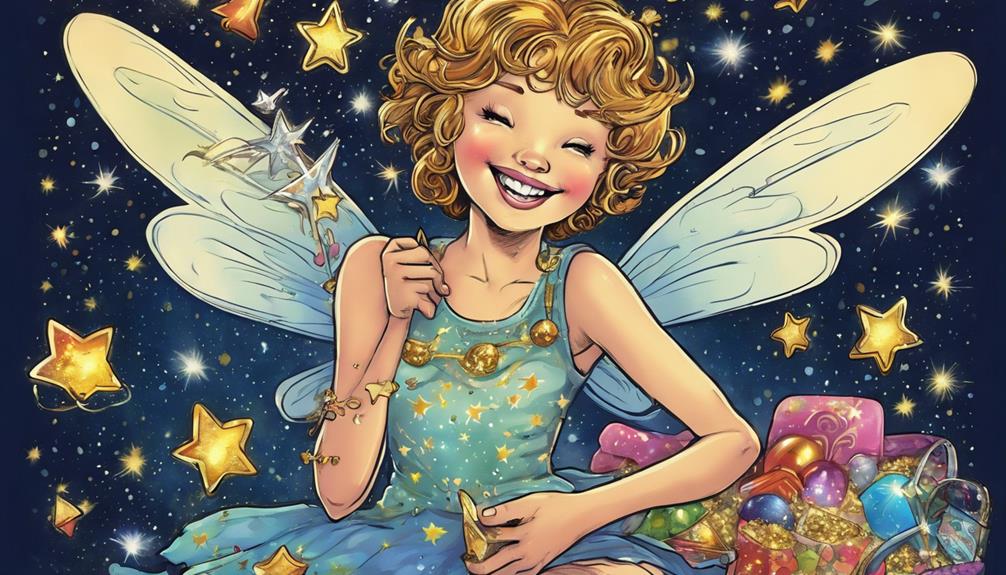
When it comes to Tooth Fairy payouts, several factors come into play.
You'll notice that regional differences can lead to varying amounts, while the significance of a child's milestone tooth loss often means a higher reward.
Socioeconomic influences also shape what families choose to give, making each experience unique.
Regional Payment Variations
Regional variations in Tooth Fairy payments show that factors like location, socioeconomic status, and cultural traditions greatly influence how much kids receive for their lost teeth. You might be surprised to learn that the Northeast averages a whopping $7.36 per tooth, while the West Coast lags behind with an average of $4.08.
Here are a few key factors impacting these differences:
- Socioeconomic Status: Affluent neighborhoods tend to offer higher payouts than lower-income areas.
- Age Variations: Older kids, especially those aged 11-12, usually see higher amounts than younger children aged 6-7, likely due to their better understanding of money.
- Cultural Traditions: Different regions may have unique customs that influence the going rate for lost teeth, leading to significant payment disparities.
These factors show how the generosity of Tooth Fairys can vary widely, affecting how much kids find under their pillows.
Milestone Significance
Celebrating milestones, like a child's first lost tooth, can lead parents to offer higher Tooth Fairy payouts as a way to honor this special moment.
The first tooth often garners a larger reward, typically exceeding the average amount, as it marks a significant development in a child's life. Parents recognize the emotional importance of this event and are willing to reflect that in their payouts.
When it comes to milestone significance, payments can range from $5 to $20 for notable dental developments, emphasizing how much value parents place on these occasions. Not only does the type of tooth lost matter, but the visibility and readiness of that tooth can also affect the payout. A more noticeable first tooth might earn a child a heftier reward.
Additionally, some parents may choose to go beyond cash, offering non-monetary gifts or special treats to commemorate the moment, especially for significant milestones like losing a first molar.
Ultimately, how much the Tooth Fairy leaves under the pillow often reflects both the emotional weight of the occasion and the family's traditions surrounding these memorable milestones.
Socioeconomic Influences
Socioeconomic factors play an essential role in determining how much the Tooth Fairy leaves under your child's pillow. The amount varies greatly based on where you live and your family's financial situation. Here are some key influences that shape these Tooth Fairy payouts:
- Regional Differences: Payments differ across regions, with the Northeast averaging $7.36, while the West Coast typically sees only $4.08. These disparities highlight the effect of local socioeconomic conditions.
- Family Income: Families in affluent neighborhoods often give higher payouts, reflecting their greater disposable income. This can create a stark contrast for children in less wealthy areas.
- Child's Age: Older children (ages 11-12) usually receive more than younger ones (ages 6-7) as they start grasping the value of money.
Additionally, considerable milestones, like losing a first tooth, often lead to larger rewards.
Parental income and educational backgrounds shape expectations, influencing how much you might decide to leave. Understanding these socioeconomic influences can help you navigate the Tooth Fairy's world more effectively.
Promoting Dental Health Through Tradition
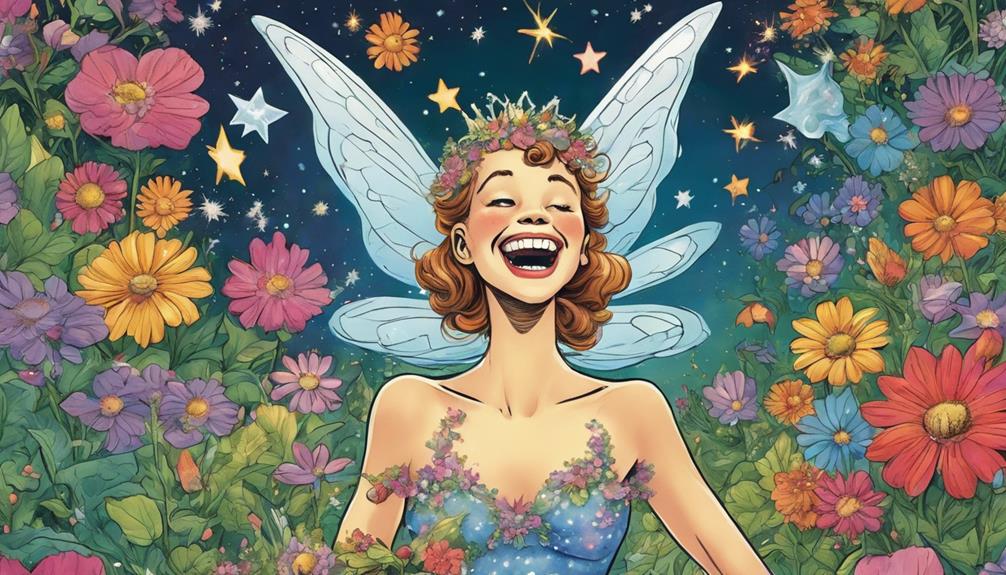
The Tooth Fairy tradition not only excites children about losing teeth but also encourages them to take charge of their dental health. By linking the excitement of a visit from the Tooth Fairy with dental milestones, you can motivate your child to practice good oral hygiene.
For instance, consider rewarding them for regular dental check-ups or proper brushing techniques. This way, you're reinforcing positive behaviors while making dental care a fun experience.
As the average Tooth Fairy payment rises, it reflects a cultural emphasis on rewarding dental achievements, which can inspire your child to prioritize their oral hygiene. When children know that their efforts in caring for their teeth could lead to higher rewards, they're more likely to take their responsibilities seriously.
Incorporating the Tooth Fairy into lessons about dental care fosters awareness and responsibility in your child. It transforms the process of losing teeth into a teachable moment about the importance of maintaining their oral health.
Cultural Significance of the Tooth Fairy

Rooted in ancient traditions, the Tooth Fairy serves as a comforting figure that helps children navigate the often challenging experience of losing their teeth. This delightful character transforms a potentially scary moment into a magical one, making it easier for kids to cope with the change of losing their baby teeth.
The Tooth Fairy's cultural significance spans various aspects:
- Rite of Passage: The tradition symbolizes growth, as losing baby teeth marks a child's development into a new stage of life.
- Family Bonding: Engaging in this whimsical practice fosters connections among family members, creating shared memories that parents and children cherish.
- Local Variations: Different regions celebrate the Tooth Fairy in unique ways, with varying payment amounts reflecting local customs and socioeconomic factors.
Ultimately, the Tooth Fairy has evolved from ancient practices, like the Norse tooth fee, to a beloved icon that alleviates fears and enhances the experience of losing baby teeth. This enchanting figure continues to capture the hearts of families, making the journey of dental milestones memorable.
Tips for a Memorable Experience
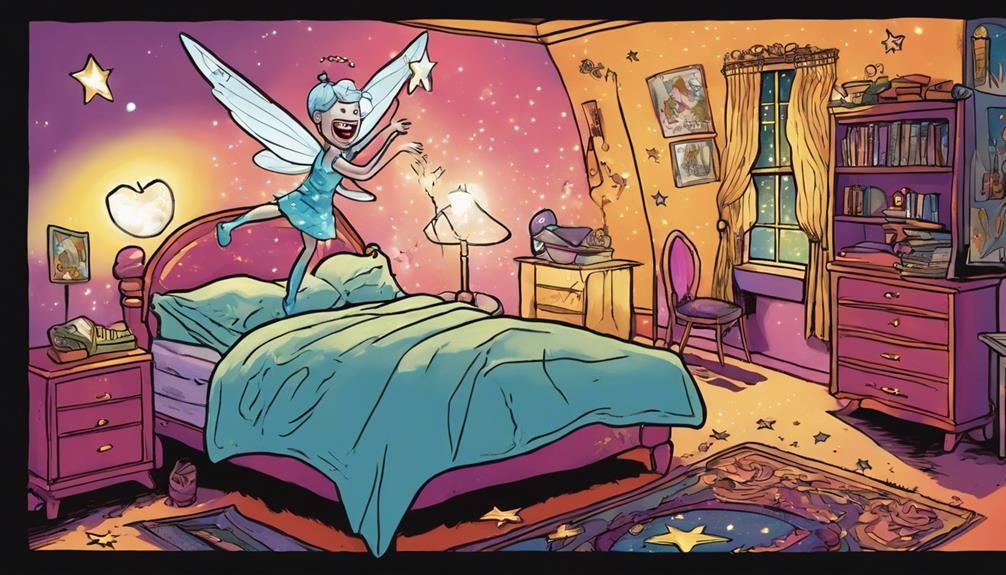
To make the Tooth Fairy experience truly magical, try personalizing it with a special note or letter that your child can treasure. This small gesture can enhance the excitement and make the moment feel extraordinary.
You might also consider adding a themed gift along with the cash, like a toy that reflects your child's interests. This adds a layer of creativity and imagination to the memorable experience.
Establishing a consistent Tooth Fairy routine can heighten the anticipation. Choose a specific night for tooth exchanges, allowing your child to look forward to each event. Encourage them to leave a snack for the Tooth Fairy, adding an interactive element that enriches the tradition.
Additionally, use this opportunity to teach your child about money. Introduce simple math concepts, like counting coins or discussing the value of the Tooth Fairy gifts. This not only makes the experience educational but also helps your child appreciate the significance of their lost tooth.
Frequently Asked Questions
How Much Are Teeth Worth From the Tooth Fairy?
Teeth can be worth anywhere from $1 to $20, depending on factors like your location, your age, and whether it's your first lost tooth. The average payout hovers around $6.23 these days.
How to Answer What the Tooth Fairy Does With Teeth?
When kids ask what the Tooth Fairy does with teeth, you can say she collects them to build castles, sprinkles them for stars, or crafts magical gifts for other children, making losing teeth a fun adventure.
Why Does the Tooth Fairy Give Different Amounts of Money?
The Tooth Fairy gives different amounts of money based on factors like regional traditions, socioeconomic status, and the child's age. You might notice higher payouts for first lost teeth or special dental milestones, too.
What Is the Tooth Fairy Rule?
Isn't it delightful when magic touches childhood? The Tooth Fairy Rule lets you place lost teeth under your pillow, where you'll find a surprise in exchange, turning a simple loss into a cherished memory.
What Toothpastes Are Recommended by Dental Experts for Maximum Tooth Value?
For those with cavityprone teeth, dental experts recommend the best toothpastes for cavityprone teeth that contain fluoride to strengthen enamel and prevent decay. Look for brands like Colgate, Crest, and Sensodyne, which are often recommended for their effective cavity-fighting formulas. Maintaining good oral hygiene with these toothpastes is crucial for maximum tooth value.
Conclusion
So, as you tuck those tiny treasures under your pillow, remember the magic of the moment.
The Tooth Fairy's trade isn't just about shiny coins or sweet surprises; it's a celebration of smiles and the journey of growing up.
Whether your child's teeth are cherished collectibles or just everyday enamel, each one holds a special story.
Embrace the enchanting experience, and let your little one's laughter echo as you create delightful memories that sparkle forever!
